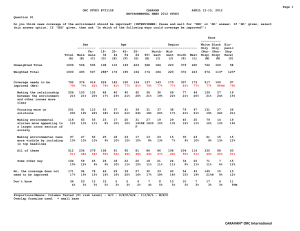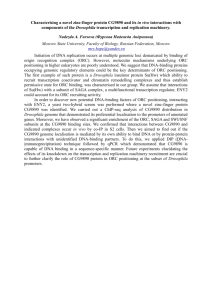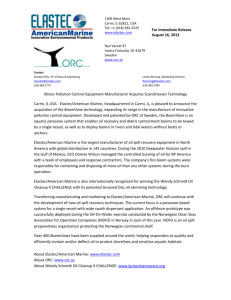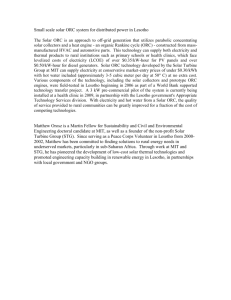Fighting back against organized retail crime - Matt
advertisement
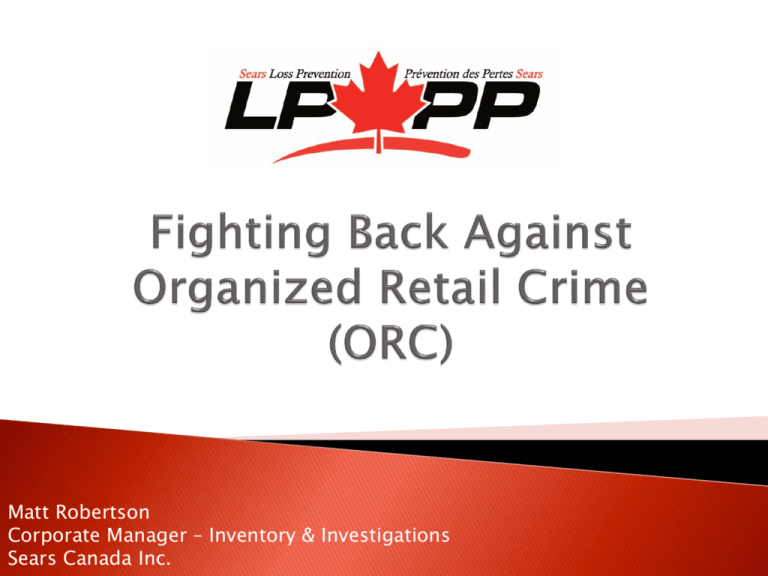
Matt Robertson Corporate Manager – Inventory & Investigations Sears Canada Inc. Agenda • • • • • • • • • • • • • • • • • Background About Sears Canada What is ORC? ORC Statistics Why Retail? Initial ORC Program at Sears Project Vanilla – First Major ORC Investigation Key Learning's Moving Forward Revised ORC Program at Sears Standard Evidence Packages BOLO Program Data Analytics Project Xtreme – Recent ORC Investigation Sears ORC Statistics What is next? Questions??? Background • • • • • • • • Come from a family of Police/Private Investigators. • Grandfather – O.P.P. • Father – Peel Police/Private Investigation Started in the industry in 2006. Began career as a Computer Forensic Examiner. Obtained Private Investigators license. Worked with many Fortune 500 companies as well as most police agencies throughout Ontario on investigations ranging from Insurance Fraud to Major Organized Crime investigations. Joined Sears in 2009 within the Loss Prevention department. In 2012, built the framework for the ORC Program. In 2014, promoted to title of Corporate Manager – Inventory & Investigations. • Oversee all Investigations throughout Canada (Internal & External) • Program has expanded to a National level. Sears Canada Inc. • Multi-Channel Retailer • 167 Corporate Stores • Full Line, Home, A&M, Outlet • 197 Hometown Stores • 1300 Catalogue & Online Pickup Locations • 85 Travel Offices • Loss Prevention resources and training is available to all units • 19000 employees within all channels What is ORC? • Organized Retail Crime (ORC) refers to professional shoplifting, cargo theft, retail crime rings and other organized crime occurring in retail environments. These criminals move from store to store and even city to city. They typically are observed working in teams and have a high level of knowledge of how Loss Prevention operates. • Some of the main types of ORC criminals include: • • • • • • High frequency fraud refunders Boosting/Fencing Operations Habitual Offenders E-commerce fraud orders Organized Credit Card fraud Groups that use tools, vehicles, etc. ORC Statistics • ORC Stats are simply not tracked in Canada the way that they are in the United States. • Retail crime costs Canadian retailers nearly $5 billion per year. • Only 5.32% of retailers have dedicated ORC employees. • Retail sales dropping, but ORC activity increasing. • 28% of retailers reported overall losses of more than $500,000 a year to Organized Retail Crime (ORC). • 56% of retailers report that they apprehended individuals linked to ORC. • In the United States in 2014, 88% of retailers believed they were a victim of Organized Retail Crime. • In the United States, 52% of retailers noticed a reduction in ORC activity once proper laws were put in place. Why Retail? • There are not strong enough laws in Canada to help combat ORC effectively. • Retail is the path of least resistance. • ORC is a low risk/high profit crime. • Merchandise can quickly be turned into cash. • Many retailers do not have the resources to be able to combat ORC effectively. • With the advancement of technology and websites such as Craigslist, Kijiji, or EBay, criminals can sell their merchandise quicker and for a lot more than at traditional pawn shops. • For return fraud cases, the criminals can easily get up to 100% of the value of the merchandise back in gift cards or cash. Initial ORC Program • In 2012 the ORC program was developed at Sears. It initially Started in Ontario only with a primary focus on the GTA locations. • Worked to develop training programs for the stores to understand ORC and the type of cases involved. • Created the first version of the BOLO (Be On the Look Out) to establish quick communication between stores on repeating suspects. • Created a process for ‘Apprehension Interviews’ where we would engage the arrested suspect in conversation to attempt to determine if they were a repeat offender. • Established relationships with other retailers and police agencies and set up regular meetings to discuss recent cases. • Increased physical protection strategies highly targeted ORC items. Project Vanilla • In 2012, Sears began selling third party gift cards in our stores. This included pre-paid Vanilla MasterCard's (VMCs). • Sales quickly increased for these items and a growing trend was identified of fraudulent transactions where counterfeit credit cards were used to purchase the gift cards. • Through some initial automated reporting and analysis, it was identified that there were several repeat occurrences in the GTA where a single credit card would purchase large quantities of VMCs but spanned across several different locations over a period of a couple days. • Began gathering evidence and trying to obtain any CCTV/evidence for the incidents. • Identified one primary suspect that had used over 75 counterfeit credit cards to purchase approximately $40,000 worth of VMCs over a period of five months. Project Vanilla • Conducted regular surveillance on the suspects address, which resulted in identifying two additional suspects and several additional vehicles. • Worked with Halton police on the investigation who spearheaded the entire project. Investigation spanned into 10 different police jurisdictions and involved 15 different Sears locations ranging from Waterloo to Ottawa. • Warrant was executed on suspects primary residence. Identified a large quantity of evidence, including dressers and closets full of new undershirts, boxers, and hand towels. • Canada wide warrant issued for his arrest. Was arrested in BC and brought back to Ontario for trial. Was charged in Halton and Brantford and received over one year in jail. Key Learning's • Quickly realized that there was a significant amount of activity, specifically around credit card fraud and return fraud. Realized the need for more resources. • Hit minor road blocks in dealing with police agencies as our quality of evidence and fraud reporting was not to a set standard. Varied across the country. • Needed to establish more training programs, not just for Loss Prevention but the retail sales associates on how to better identify ORC activity. • Internal policies needed to be updated to reflect the growing rise in return fraud and how we handle gift card transactions. • Needed to look at the use of data analysis to try and catch the ORC activity quicker. Moving Forward… • What can we do to obtain evidence and information from our stores to be able to action the case as quickly and effectively as possible? • What can we do to ensure that we are obtaining high quality evidence across the board? • How do we be sure that our standard stays the same no matter which market the case takes place in as most cases span across multiple markets? • How do we ensure that police agencies want to take our cases and pursue charges? • How do we ensure our policies and procedures are regularly updated to meet the changing trends? • How do we leave a lasting impression with ORC groups so they don’t return? Revised ORC Program • Between 2012 and 2014, the ORC program continued to grow to a national level with ORC representation in all major cities (Vancouver, Montreal, Toronto, Ottawa). In 2014 the ORC program was further revised and updated to continue with the growing increase in activity. • Updated and specialized training programs were rolled out to all Loss Prevention teams across the country. • Advanced reporting and analytics were put in place to assist in identifying fraud cases quicker and with greater success. • Continued to establish relationships with other retailers and police agencies to further promote information sharing. • Revitalized the BOLO and LP Call Tree programs. • Create a standardized report structure for ORC cases, as well as an ORC Investigative process (and supplemental training resources). Sears ORC Team - Responsibilities • The ORC team within Sears Canada has several key responsibilities in assisting the organization in reduction of shrink through the prevention of ORC activities. Some of these responsibilities include: • Software testing to identify high-frequency refunders • Identification and validation of offenders • Chargeback analysis to identify offenders and trends • In depth analysis on repeat offenders • BOLO System with LP Call Tree • Partnerships with other retailers (Specifically their ORC teams) • Regular meetings with other retailers and police departments • Targeted surveillance on subjects, fencing locations, websites, social media •Increased data analytics and development of new programs to catch fraudulent activity. What do we count as ORC Investigations? • Grab and run cases where multiple of the same item or similar items are taken. (Eg. Clothing taken in several colors and sizes). • Grab and run cases involving big ticket items. • Repeated issues with the same people/vehicles. • Arrest of someone using boosting devices (bag, skirts, boxes) • Sweep thefts (where entire shelves, racks or tables are stolen). • Arrest of someone who tells you that they are being paid to steal for someone else. • Fraud (Credit Card Fraud, Return Fraud). • Large scale internal investigations. ORC Investigative Flow ORC Case is Identified. LP Team is Sent a RFE (Request for Evidence). LPAMs are all copied on this request. LP Team is required to generate 731R Case number and reply to ORC Investigator with number. ORC Investigator to input all 731R details into “ORC Case Management File” on Q drive. All Files are uploaded to the Q drive within the designated folder for Evidence. LP Team completes the RFE within seven (7) days. LP Team to access ORC Management File and extract relevant data to input into units 731R Case Mgmt System. LP Team and ORC Investigator to communicate on any further updates to investigation. ORC Investigator to communicate on if Police Occurrence Number is generated, ORC Investigative Flow • Live Case • Police Contacted • Call Tree is initiated • ORC Team advised • BOLO is created • Evidence Gathering (CCTV/Statements/Receipts) • Store creates internal case number • Potential Case • ORC Team advised • BOLO is created • Evidence Gathering (CCTV/Statements/Receipts) • Communication with Police and other retailers to potentially identify suspect(s). Standard Evidence Packages • Worked with multiple police agencies to determine what the ‘gold’ standard of an evidence package would be. • Created a standardized report that used the feedback from police agencies that was rolled out nationally. • Determined the three primary pillars of evidence required for a successful investigation: 1) 2) 3) CCTV Footage Witness Statements Receipts and other Evidence Three Pillars Witness Statements Receipts and other Evidence PVMs or any possible store entrances/exits Operating Associate for transaction Photocopy of Merchant copies of receipts Footage from CSD Any other potential witnesses Any other physical evidence (i.e. Merch Gift Cards) Other Cameras that might have captured suspect(s) in frame Investigator Statement(s) CCTV Footage CCTV Footage • CCTV footage is an absolutely crucial piece of evidence for any investigation. • For ORC cases, it is extremely important to capture any evidence of the suspect(s) within • Often times, although an occurrence might have taken place at a Customer Service Desk (CSD), it is not the only place we should be looking for evidence. • • • PVMs or any camera that covers an entryway to a store. The suspect(s) had to have entered the store somewhere, and there might be a quick shot of them entering or exiting the store. Other cameras that are within walking distance of the department that the suspect may have entered or crossed through. The actual CSD where the transaction(s) took place. CCTV Synopsis • Created a standard template that could be used for any investigation. • Used to timeline and provide detail on what is on the CCTV. • Kept separate from a regular statement. • Regularly used for ORC investigations and has received tremendous feedback from multiple police agencies. Witness Statements • Witness statements are another crucial piece to the investigative puzzle. • Unlike a theft case, where a statement from the Loss Prevention Investigator may be the only one needed, in an ORC case, having multiple statements is very important to ensuring a successful investigation. • There are several key people who should be writing statements for an ORC Investigation. • • • Any Loss Prevention personnel involved in the incident. If the ORC case is a fraud, a statement from the operating associate for the fraudulent transaction(s). Any potential witnesses to the incident (i.e. Other Sales associates who witnessed the ORC incident). BOLO Program (Be On Look Out) • The BOLO template was created in 2012 to allow stores to effectively communicate potential ORC suspects to nearby stores. • Since its initial design, it has been modified and updated several times to ensure it captures the best possible data relevant to the investigation. • The BOLO template has proven to be a very important tool and has become a staple of our Loss Prevention investigation tool kit. • In order to simplify sending BOLO’s, we created several internal distribution lists to ensure BOLO get’s to all relevant parties as quick as possible. BOLO Template LP Call Tree • It was realized that although email is a great way to share information, it may not be fast enough if the Loss Prevention team is not in front of a computer. • Developed an internal call tree to quickly spread the message to nearby stores if an ORC incident takes place. • A physical map was created that branches out across all stores. • Stores are required to call those that branch out from them, sharing information that needs to be learned quickly (i.e. Identity or description of subject, vehicle description, brief description of incident.) • The initial store will then create and distribute a BOLO immediately following the initiation of the call tree. Project Xtreme • Identified a trend of customer orders that needed to be re-picked and rescheduled as they appeared to have been gone missing while in transit or in staging at the delivery facility. • Began investigation and conducted regular surveillance on the 3rd party delivery team. • Through surveillance, determined that members of the 3rd party delivery team were working with an organized crime group in the GTA. • Case involved over $1 Million dollars in merchandise. • A total of seven people were arrested and charged as part of the investigation. • A search warrant was conducted on two storage lockers as well as a business, resulting in the recovery of $250,000 worth of merchandise. Advanced Data Analytics • Utilized ACL, a software solution that allows the user to input transaction data (sales, returns, etc) and analyze it in a high level format to look for suspicious patterns. • Can be used to analyze customers who are doing an excess number of returns, cancellations, or allowances. • Can be used to analyze for credit cards being used in multiple stores over a large geographical region. • Can analyze the purchasing and quick spending of gift cards. • Can be used to analyze large purchases of prepaid MasterCard's or other similar items • Can be used to look for customers who are using variations of their names, phone numbers, addresses, etc for the purpose of doing No Bill Returns. ACL Data Analysis ORC Automated Reporting • Weekly NBR (No Bill Return) Report • Pulled Weekly and Reviewed by Retail Stores • All Gift Cards Activated • Pulled Daily • Third Party GC Purchases with Credit (Over $100) • Pulled Daily • Gift Card Swap Report (GCs used to buy other GCs) • Pulled Weekly • Credit Cards Used Same Day In Multiple Stores • Pulled Daily • Method of Entry Analysis (Swipe/Tap/Manual Entry) • Pulled Daily Training/Internal Communication • In order for ORC to continue to be effectively attacked, it needs to be part of the day to day culture throughout the retail stores and the Loss Prevention department. • Training needs to stay relevant and needs to take place regularly to ensure it is always fresh. • All new associates need to ensure they have gone through training around spotting and dealing with ORC investigations. • Internal policies need to be adapted to ensure they are current with the growing trends. • Eg. Not allowing the purchase of gift cards with other gift cards. • Ensuring No Bill Returns are not processed to a standard gift card. • Specific Merchandise Gift Card. ORC Awareness Campaign Examples of Internal Training Resources • Statement Writing Package • Tips and examples of a successful statement, not only for ORC cases but any statement. • Dealing with Credit Card Fraud • A how to for the Loss Prevention Team as well as the CSD/Sales associates on dealing with Credit Card Fraud • Dealing with NBR (No Bill Return Fraud) • A how to for the Loss Prevention Team as well as the CSD/Sales associates on dealing with NBR Fraud • ORC Investigation Flow • Documentation on how ORC cases should be handled, as well as training documentation on best practices for handling evidence, witness statements, etc. Sears ORC Statistics • In 2014, due to an increase in training of retail store associates on credit handling procedures, as well as increased monitoring and analysis by the Loss Prevention team, the amount of Credit Card Chargebacks was reduced by over $700K compared to 2013. • In 2014, the ORC team handled over 400 cases related to ORC activity. This resulted in over $1.5 million in recovery. • YTD in 2015, the ORC team has already handled over 150 cases related to ORC activity with a recovery of over $200K. • Majority of cases handled have been Credit Card Fraud Cases. • Growing trend in the Western part of Canada for ORC activity. Specifically ‘Theft of Merchandise’ type cases involving grab and runs. • Growing increase of number of internal cases that relate to ORC activity. • Decline in number of Fraud Return cases as stricter rules were placed around No Bill Return transactions and increased vigilance at the customer service desks. What is next? • Continuation of Advanced Data Analytics. • Project PORC (Predictive Organized Retail Crime). • Legislation to support ORC cases. • Increased partnerships with other retailers and police agencies. • New and improved information sharing platforms. • TAPPS, Retail COP • Revised Internal BOLO Program. • Internal web based platform for instant communication and validation of offenders. • Infiltration of ORC suspects into retail stores. Questions ???
